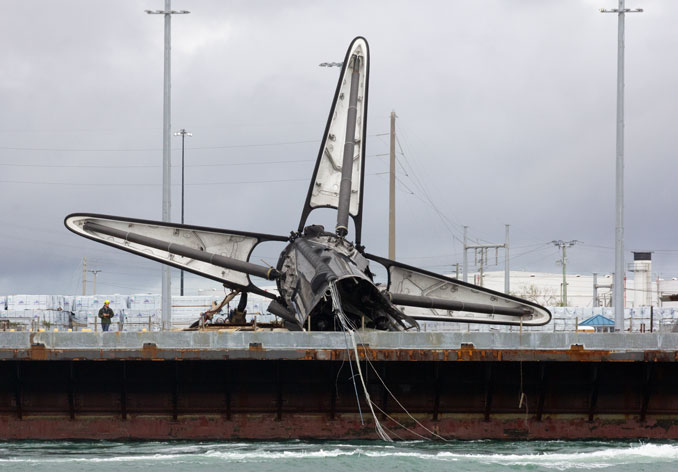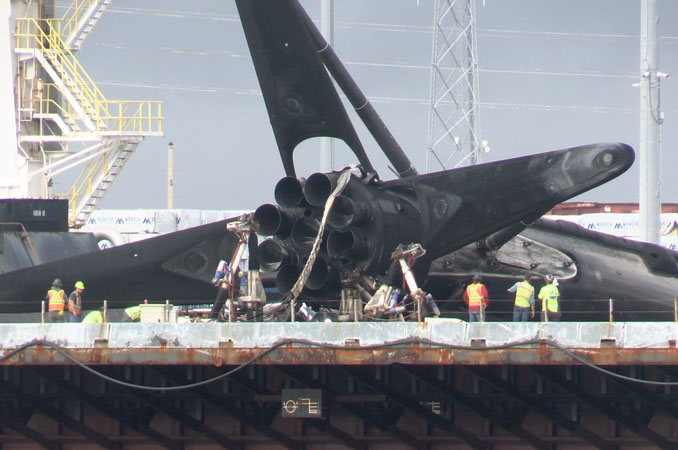
The remains of Falcon 9 booster 1058 arrive at Port Canaveral after the vehicle toppled over and broke apart in bad weather. Image: Steven Young/Spaceflight Now.
Falcon 9 ブースター 1058 の残骸は、悪天候で車両が転倒して分解された後、ポート・カナベラルに到着しました。画像: Steven Young/Spaceflight Now。
A piece of America’s space history is now on the ocean’s floor. During its return voyage to Port Canaveral in Central Florida, a SpaceX Falcon 9 first stage booster toppled over and broke in half.
アメリカの宇宙史の一部が今、海底にあります。フロリダ中央部のポート・カナベラルへの帰路中、スペースX社のファルコン9の第1段ブースターが転倒し、真っ二つに砕けてしまった。
This particular booster, tail number B1058, was coming back from its record-breaking 19th mission when it had its fatal fall. The rocket lifted off from Cape Canaveral Space Force Station on Dec. 23 carrying 23 Starlink satellites. The booster made a successful landing eight and a half minutes after launch on the drone ship ‘Just Read the Instructions’ which was stationed east of the Bahamas. SpaceX said in a statement on social media that it succumbed to “high winds and waves.”
この特定のブースター、尾翼番号 B1058 は、記録破りの 19 回目のミッションから帰還中に致命的な落下を経験しました。ロケットは12月23日に23個のスターリンク衛星を乗せてケープカナベラル宇宙軍基地から打ち上げられた。ブースターは、バハマ東方に駐留していたドローン船「ジャスト・リード・ザ・インストラクション」への打ち上げから8分半後に着陸に成功した。スペースXはソーシャルメディア上の声明で、「強風と波」に屈したと述べた。
The company stated that “Newer Falcon boosters have upgraded landing legs with the capability to self-level and mitigate this type of issue.
同社は、「新しいファルコンブースターは、自己水平化機能を備えた着陸脚をアップグレードし、この種の問題を軽減します」と述べています。
In a separate post, Kiko Deontchev, the Vice President of Launch for SpaceX, elaborated by added that while they “mostly outfitted” the rest of the operational Falcon booster fleet, B1058 was left as it was, “given its age.” The rocket “met its fate when it hit intense wind and waves resulting in failure of a partially secured [octo-grabber] less than 100 miles from home.”
スペースX社の打上げ担当副社長キコ・デオンチェフ氏は別の投稿で、残りの運用可能なファルコンブースター艦隊の「ほとんどの装備を整えた」一方、B1058は「老朽化を考慮して」そのまま残されたと付け加えて詳しく説明した。ロケットは「激しい風と波に遭遇し、自宅から160マイルも離れたところで部分的に固定されていた[オクトグラバー]が故障し、その運命を迎えた」。

SpaceX crews examine the wreckage of booster 1058 after the drone ship arrived at the dock at Port Canaveral. Image: Steven Young/Spaceflight Now.
スペースXの乗組員は、ドローン船がカナベラル港のドックに到着した後、ブースター1058の残骸を調査した。画像: Steven Young/Spaceflight Now。
“We came up with self-leveling legs that immediately equalize leg loads on landing after experiencing a severe tippy booster two years ago on Christmas,” Deontchev wrote, referring to the first flight of the B1069 booster.
デオンチェフ氏はB1069ブースターの初飛行について、「2年前のクリスマスにひどい転倒を経験した後、着陸時に脚の荷重を即座に均等にするセルフレベリング脚を思いついた」と書いた。
“One thing is for sure, we will make lemonade out of lemons and learn as much as possible from historic 1058 on our path to aircraft-like operations,” he added.
「一つ確かなことは、我々はレモンからレモネードを作り、航空機のような運用を目指す上で歴史的な1058号から可能な限り多くのことを学ぶだろう」と付け加えた。
An American tail(number)
Beyond its status as the flight leader in SpaceX’s Falcon fleet with 19 completed missions, B1058 also held the distinction of launching astronauts from American soil for the first time since the end of the Space Shuttle program in 2011.
アメリカの尾翼(番号)B1058は、19のミッションを完了し、スペースX社のファルコン艦隊のフライトリーダーとしての地位を超えて、2011年のスペースシャトル計画終了以来初めてアメリカ本土から宇宙飛行士を打ち上げるという功績も残した。
Former NASA astronauts Bob Behnken and Doug Hurley were the first to climb aboard a SpaceX Crew Dragon spacecraft to fly to the International Space Station on May 30, 2020. That historic mission, dubbed Demo-2, began the illustrious mission career of B1058 that spanned more than three years.
元 NASA 宇宙飛行士のボブ・ベンケン氏とダグ・ハーリー氏は、2020 年 5 月 30 日にスペース X クルードラゴン宇宙船に初めて乗り込み、国際宇宙ステーションに向かいました。デモ 2 と呼ばれるこの歴史的なミッションは、B1058 の輝かしいミッションのキャリアの始まりであり、その期間は多岐にわたりました。 3年以上。
To mark its landmark flight, the booster was emblazoned with both the official NASA logos, nicknamed the “meatball” and the “worm.” This became the first crewed flight in NASA’s Commercial Crew Program, which began a new chapter of the agency purchasing commercial services to shepherd astronauts to and from the orbiting outpost.
その画期的な飛行を記念して、ブースターには「ミートボール」と「ワーム」という愛称を持つ NASA の公式ロゴが両方とも飾られました。これはNASAの商用乗組員プログラムにおける初の有人飛行となり、宇宙飛行士を周回する前哨基地まで送迎する商用サービスを購入するNASAの新たな章が始まった。
When the booster was being prepared for the Demo-2 mission, NASA and SpaceX determined the loss-of-crew (LOC) probability to be 1-in-276, beating the program-required threshold of 1-in-270.
ブースターが Demo-2 ミッションに備えて準備されていたとき、NASA と SpaceX は乗組員喪失 (LOC) の確率が 276 分の 1 であり、プログラムで要求されるしきい値である 270 分の 1 を上回っていると判断しました。
Crew Dragon Endeavor docked with the ISS 19 hours after launching from NASA’s Kennedy Space Center in Florida.
クルードラゴン・エンデバーは、フロリダ州のNASAケネディ宇宙センターから打ち上げられてから19時間後にISSにドッキングした。
While the Demo-2 flight was the only crewed mission using B1058, the booster did support one additional mission to the Space Station when it launched a Cargo Dragon spacecraft, designated C208, on SpaceX’s 21st Commercial Resupply Services (CRS-21) mission on Dec. 6, 2020.
Demo-2飛行はB1058を使用した唯一の有人ミッションでしたが、12月にスペースXの第21回商業補給サービス(CRS-21)ミッションでC208と指定されたカーゴドラゴン宇宙船を打ち上げたとき、ブースターは宇宙ステーションへの追加ミッションを1つサポートしました。 . 2020年6月。
The other 17 flights of this booster included the first and third of SpaceX’s Transporter missions, carrying an array of CubeSats and NanoSats to orbit, as well as 14 missions to send up satellites for SpaceX’s Starlink internet constellation.
このブースターの他の 17 回の飛行には、一連の CubeSat と NanoSat を軌道に運ぶ SpaceX の Transporter ミッションの 1 回目と 3 回目と、SpaceX の Starlink インターネット コンステレーションに衛星を送信する 14 回のミッションが含まれていました。
Gone, but not forgotten
On Tuesday, Dec. 26, the remaining portion of B1058 was brought into Port Canaveral onboard ‘Just Read the Instructions.’ A collection of photographers, reporters and on-lookers gathered along the entryway to the port to catch a glimpse of what was left of the booster.
消え去ったが忘れられてはいない12 月 26 日火曜日、B1058 の残りの部分が「説明書をお読みください」船上でポート・カナベラルに持ち込まれました。写真家、レポーター、見物人が港への入り口に沿って集まり、一目見ようとしました。ブースターの残り物。
Most of the engine section of the rocket appeared to be in tact, judging from photos and three of the four landing legs jutted into the air, propped open as they were following the booster’s landing.
写真から判断すると、ロケットのエンジン部分の大部分は無傷であるように見え、4本の着陸脚のうち3本が空中に突き出ており、ブースターの着陸に続いて開いたままになっていた。

The crumpled base of booster 1068, spewing cables and pipes, enters Port Canaveral on Dec. 26, 2023. Image: Steven Young/Spaceflight Now.
ケーブルとパイプを吐き出しながら、しわくちゃになったブースター 1068 の基部がカナベラル港に入る。2023 年 12 月 26 日。画像: Steven Young/Spaceflight Now。
Looking from the top of the booster remnants, wires were drawn out and strewn over the edge of the droneship, dragging in the water as the vessel made it back to its dock.
ブースターの残骸の上から見ると、ワイヤーが引き出され、ドローンシップの端に散らばり、船がドックに戻る際に水を引きずっていました。
While B1058 will never fly again, SpaceX fully intends to preserve what’s left and understand what they can.
B1058が再び飛行することはありませんが、SpaceXは残されたものを保存し、何ができるかを理解するつもりです。
“We are planning to salvage the engines and do life leader inspections on the remaining hardware,” said Jon Edwards, the Vice President of Launch Vehicles and Falcon 9 Product Director at SpaceX. “There is still quite a bit of value in this booster. We will not let it go to waste.”
「私たちはエンジンを回収し、残りのハードウェアのライフリーダー検査を行う予定です」とSpaceXの打ち上げロケット担当副社長兼ファルコン9プロダクトディレクターのジョン・エドワーズ氏は語った。 「このブースターにはまだかなりの価値があります。私たちはそれを無駄にはさせません。」


 Optimisus
Optimisus Optimisus
Optimisus Optimisus
Optimisus Thecryptoupdates
Thecryptoupdates DogeHome
DogeHome The Crypto Times
The Crypto Times Coincu
Coincu Optimisus
Optimisus Coin_Gabbar
Coin_Gabbar






















